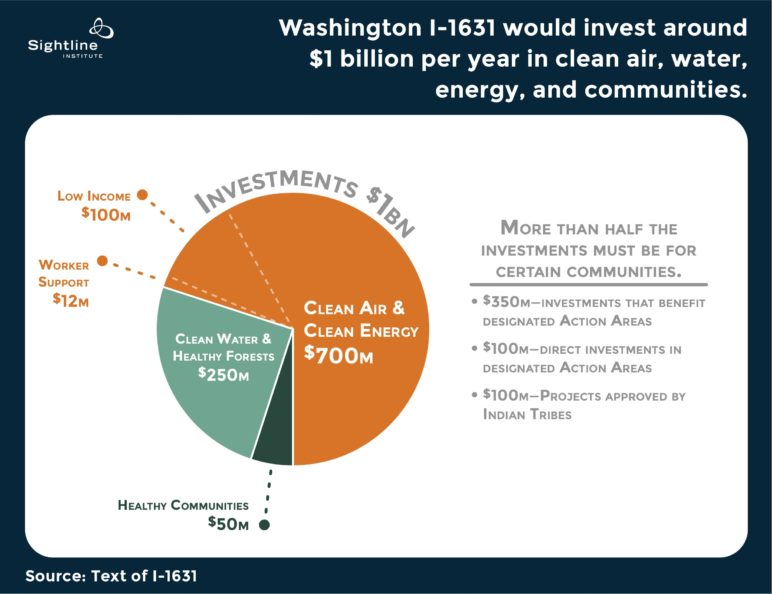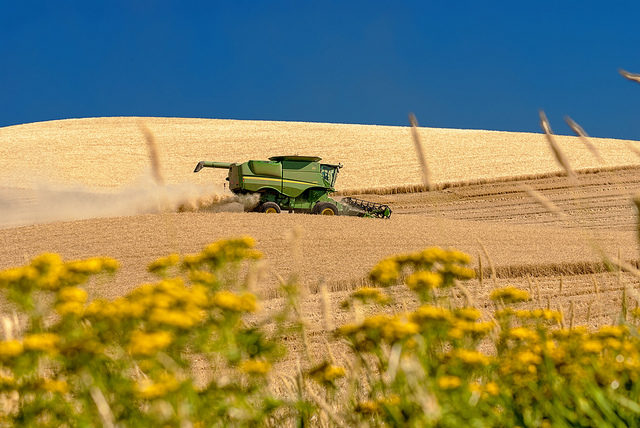Initiative 1631 is poised to bring a host of benefits to all corners of Washington, including rural communities. The climate action bill could make way for wind and solar farms located in rural areas, encourage the use of manure digesters on Washington dairy farms, and protect remote communities against flooding and wildfires.
I-1631 would charge the state’s big polluters a fee, raising close to $1 billion per year for the foreseeable future. The initiative requires the money be put to work by investing in clean energy, clean water, healthy communities, and healthy forest projects.

Original Sightline Institute graphic, available under our free use policy.
Opportunities for projects abound, but specifics will ultimately be up to a Public Oversight Board (see section 10), advised by Three Investment Advisory Panels (see section 11). But we can still make some educated guesses about the types of projects that would qualify and how they could benefit people in Washington.
Investments in Clean Water and Healthy Forests
A quarter of I-1631 revenue must be invested in “clean water and healthy forest investments” and many of these investments will benefit people in rural Washington. Investments in water, for example, could include restoring and protecting estuaries, marine shorelines, and fisheries, as well as restoration of natural floodplains, reducing flood risk, and green stormwater infrastructure. Forest investments could improve forest management practices and reduce vulnerability to forest fires. They could support industries such as cross-laminated timber and other mass timber technologies.
Money from I-1631 would both protect and bolster rural communities through preventative and restoration projects and job creation. Two examples:
- Around the Upper Quinault River, roads often get washed out from flooding and storm surges. This affects residents’ homes as well as access to Olympic National Park. A restoration plan funded by I-1631 could provide more resilient road access, prevent washouts, and restore fish and wildlife habitat.
- Flooding also threatens communities along the Snohomish River. There’s already a plan to restore estuaries and provide the community with a floodplain buffer that would absorb storm surges but it is, to date, unfunded. The role I-1631 could play is obvious.Community forests are long-term economic engines for rural counties, creating millions of dollars annually through increased jobs, timber production, and storage of carbon dioxide.

As far as forests go, I-1631 could fund the expansion “community forests,” which are owned and managed by local governments, Native American tribes and nonprofits. Recent examples include the Chimacum Ridge Community Forest in Jefferson County (850 acres, purchased with a $3.4 million grant from the state) and the Mt. Adams Community Forest in Klickitat County (389 acres, purchased for $850,000 with private donations and a contribution from the US Forest Service Community Forest Program). Community forests are long-term economic engines for rural counties, creating millions of dollars annually through increased jobs, timber production, and storage of carbon dioxide. Over twenty potential community forests have been identified and could be established with funding from I-1631.
I-1631 could help expand forest fire suppression efforts around the state. The Washington Department of Fish and Wildlife carried out a pilot project in 2010 at the Sinlahekin Wildlife Area near the Canadian border. Workers removed understory trees and bushes and to carried out prescribed burns. When wildfires struck, the pilot project area largely survived while areas that were only thinned did not. California uses its polluters-pay revenue to protect forests around the state. With I-1631, Washington could do the same and create thousands of forest jobs, preserve trees for harvest, and create biomass-to-energy opportunities. And then, of course, there’s protection of wildlife, homes, property, and lives.
Investments in Clean Air and Clean Energy
I-1631 requires a lion’s share—at least 70 percent of the revenues—to go to “clean air and clean energy” projects that reduce greenhouse gas emissions. The funding umbrella is a wide one: home weatherization, renewable energies (wind, solar and biomass, etc.), cleaner transportation options like electric buses, and all electric and hybrid electric vehicles. Many of those qualifying projects and people will be located in rural parts of the state.
The Yes on I-1631 campaign created a map of representative projects around the state.
- One example is a proposed solar project at the soon-to-close Centralia coal power plant, which would generate 180 megawatts of electricity and create about 300 construction jobs in the Centralia area.
- Another example is a proposed wind farm near Pullman, Washington, that would generate 343 megawatts of electricity—enough to power roughly a quarter-million homes. It would also create hundreds of construction jobs near Pullman.
The state might also help fund energy efficiency upgrades for local government buildings, creating local jobs and conserving taxpayers’ money that would otherwise be used to pay government building utility bills. Nine northeast states, in a program called RGGI, made polluters pay and invested the largest chunk of the revenue in energy efficiency, saving millions. Washington already has experience with this type of program. The state recently granted the city of Port Orchard, in Kitsap County, $350,000 to assist in energy efficiency upgrades to local government buildings.
Investments in Transportation
Since gasoline and diesel fuel account for the largest portion of Washington’s greenhouse gas emissions, this sector likely will receive a large chunk of funding under I-1631. Representative projects could include:
- Help for Washington’s dairy farmers to invest in dairy manure digester projects. Digesters convert methane from cow manure into biogas that can be used to generate electricity, heat homes, or power vehicles. These projects can clean a lot of global warming pollution from the air while creating a cleaner transportation fuel—a win-win for rural areas.
- Funds to support regional commuter connections and avoid single vehicle use. For example, state funds have supported the operation of a regional commuter express bus in Mason County between Bremerton and Olympia. These types of services could be expanded to connect underserved and growing communities.
- Funds to improve road infrastructure. For example, I-1631 could help fund “green street” projects that are difficult for small rural cities to fund. Puyallup is undertaking such a project to replace aging roads with porous asphalt and permeable sidewalks. It could eliminate an estimated 890,000 gallons of stormwater each year from requiring treatment, and save the city $100,000 in maintenance and other costs. Other rural cities might want to do such money-saving projects, and I-1631 could help fund them.
- Funds to support the transition of transit fleets to electric or other cleaner fuels. Transit agencies in Whatcom and Grant counties already committed to purchasing electric buses and transit agencies around the state are looking for cleaner alternatives. I-1631 could accelerate the transition.
- Funds to provide rebates or other incentives to Washington car owners to transition to all-electric or plug-in hybrid electric vehicles (plug-in vehicles have no range issues as they run on a combination of electricity and gasoline). Under the California carbon pricing program, rebates have been issued to over 150,000 California drivers to date for purchasing all electric and hybrid electric vehicles.
Investments in Community Resilience
To help prepare for challenges of climate change, 5 percent of I-1631 revenue is designated to help communities most in need. Many of these investments will be in rural communities to help them prepare for, suppress, and respond to wildfires. Some money could help relocate communities on tribal lands impacted by flooding and sea level rise.
Benefits for Rural Washington
While some people may assume that carbon pricing programs primarily benefit large urban areas, the design of I-1631 and evidence from other polluters-pay programs across North America shows that a significant portion of the funding will be invested in rural communities as well. In fact, some of the investments are designed for rural communities, such as large-scale wind and solar projects most likely to be located in rural areas, manure digesters that are on dairy farms, and healthy forest projects that will be mostly in eastern Washington, Southwest Washington, and the Olympic Peninsula. This could be the first investment program in Washington so aligned with supporting economic development in the state’s rural areas.
David Van’t Hof is a Sightline senior strategist on carbon pricing. He is an attorney in Portland, Oregon, focusing his practice in the areas of sustainability, renewable energy, and climate policy. More about David.












Alec
I have no idea where yall thought $1 billion per year, but I made a spreadsheet, https://drive.google.com/file/d/1LLthnlNmqT_Iombp6vtSCQ0MXzZVEVCp/view?usp=sharing, that factors in the mandatory 2035 targets of the state’s carbon emissions inherent in I-1631, (Sec 4. (2)(b)), to the projected statewide prices and consumption of energy of the 2019-2035 period, listed in the spreadsheet here, https://ofm.wa.gov/budget/fiscal-impact-ballot-measures-and-proposed-legislation/2018-general-election-ballot-fiscal-information. A reduction of carbon emissions in the measure appears to mostly relate to the curtailment of consumption of such fuels, looking at all the proposed actions to cut emissions throughout the measure. These fuels are really going to increase in price over the future, and this curtailment I guess saves a bunch of money overall. I can’t come close to predicting where all these carbon emission reductions would occur. I applied the estimated savings in a manner proportional to the share of carbon pollution for each sector. In any case I think we’re talking a $3.6 billion price tag for the measure vs. $41.5 billion in savings to 2035. So much of it could be unrealistic but just small fraction of savings I guess would outweigh the initial and upfront price.
Kristin Eberhard
Hi Alec,
Thanks for reading. We got the $ billion per year estimate by multiplying the taxed emissions (around 66 million metric tons) by the tax rate ($15 per ton, increasing by $2 plus inflation each year).
For more info about our revenue calculations for a Washington carbon price, you can see the notes in this article: https://www.sightline.org/2014/10/13/can-we-depend-on-the-money/
Pauline Druffel
I grew up in the Palouse Country of South Eastern Washington State where farmers grow wheat, peas, lentils, etc. I thought I had seen that some of the money could go to those farmers who were using no-till /direct seed planting because these farmers are using less fossil fuels. (They also conserve soil.) I was hoping your article would mention that idea. I’m trying to find ways to sell my family/farming friends that I-1631 would help them. I’m not so sure that taking land out of production for solar arrays would help them, although some could farm around wind turbines. My brother considered leasing some land to wind power, but at that time we didn’t have strong enough wind for the company to want to place them there. Do you know if any of the funds might go to help the Palouse farmers who do direct seed planting?
Kristin Eberhard
Hi Pauline,
Thanks for talking to your friends and family about this! I apologize for not including this in the article, but YES, no-til farming could get funding. Section 4(1)(h) of the bill authorizes funding for agricultural practices that could sequester carbon.
Harvest McCampbell
“The climate action bill could make way for . . . the use of manure digesters on Washington dairy farms . . . .”
Here in south western WA our rivers and bays are polluted with fecal coliform bacteria–which is a threat to our health and our shell fish industry. This bacteria load is primarily from beef and dairy runoff. Manure digesters would not only reduce the fecal coliform load it would reduce the methane released from the unprocessed manure.
Methane is a powerful green house gas. Methane is the third largest contributor to climate change, and many sources document that the primary source is from the beef and dairy industries.
Manure digesters are all good. This is just one tiny reason to support I-1631 in coastal WA communities.
Posted to your article with a link back on the Facebook group, Resisting Toxics in Coastal Environments.